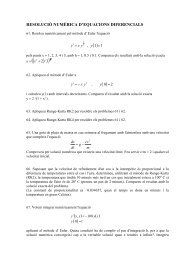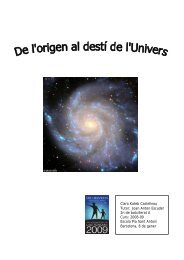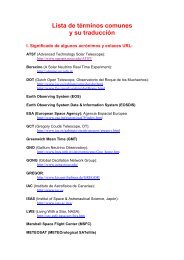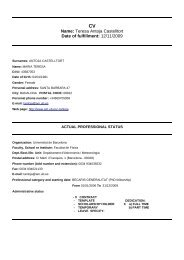Universitat de - Departament d'Astronomia i Meteorologia ...
Universitat de - Departament d'Astronomia i Meteorologia ...
Universitat de - Departament d'Astronomia i Meteorologia ...
Create successful ePaper yourself
Turn your PDF publications into a flip-book with our unique Google optimized e-Paper software.
3.1. Positions and proper motions 97<br />
Table 3.2: Proper motions estimates for LS 5039.<br />
Data set µα cos δ µδ<br />
(mas yr −1 ) (mas yr −1 )<br />
Optical 4.7 ± 1.3 −11.0 ± 0.8<br />
Radio 4.0 ± 4.9 −9.6 ± 5.3<br />
Optical+Radio 4.7 ± 1.1 −10.6 ± 1.0<br />
Although the position uncertainties from the AC 2000.2 and USNO-A2.0 cat-<br />
alogs are relatively large, the epoch span achieved justifies their inclusion in the<br />
estimate of the proper motions. Hence, from the optical data, and taking into<br />
account the astrometric uncertainties, we obtain the following results: µα cos δ =<br />
4.7 ± 1.3 mas yr −1 , µδ = −11.0 ± 0.8 mas yr −1 , where the errors come directly<br />
from the least squares fit. The two accurate radio positions give proper motions of:<br />
µα cos δ = 4.0 ± 4.9 mas yr −1 , µδ = −9.6 ± 5.3 mas yr −1 . Although this last result<br />
has a large error because only two points are available, we can say that both, the<br />
optical and radio sources, have very similar proper motions. Therefore, based only<br />
on astrometric data, we are able to confirm that both, the optical and the radio<br />
emission, originate in the same object. Hence, we will use all the data listed in<br />
Table 3.1 to compute accurate proper motions for LS 5039, which happen to be:<br />
µα cos δ = 4.7 ± 1.1 mas yr −1 , µδ = −10.6 ± 1.0 mas yr −1 . All these results are<br />
summarized in Table 3.2. We can now transform the proper motions into galactic<br />
coordinates and obtain µl = −7.2 ± 1.0 mas yr −1 and µb = −9.1 ± 1.0 mas yr −1 .<br />
It is clear from these results that there is a noticeable motion perpendicular to the<br />
galactic plane and moving away from it.<br />
According to our least squares fits, and <strong>de</strong>fining t = yr − 2000.0, the predicted<br />
ICRS values for α and δ near t = 0 are:<br />
α = 18 h 26 m 15.0565 s +<br />
δ = −14 ◦ 50 ′ 54.260 ′′ −<br />
<br />
4.7 t/ cos δ<br />
, (3.1)<br />
mas<br />
<br />
10.6 t<br />
, (3.2)<br />
mas<br />
being 9 + 1.2 t 2 / cos 2 δ and √ 9 + t 2 the errors in mas in α and δ, respectively.<br />
Comparing the fits with the positions in Table 3.1 and the proper motions in Ta-<br />
ble 3.2 we can say that, approximately, the offsets are <strong>de</strong>termined by the VLBA data






